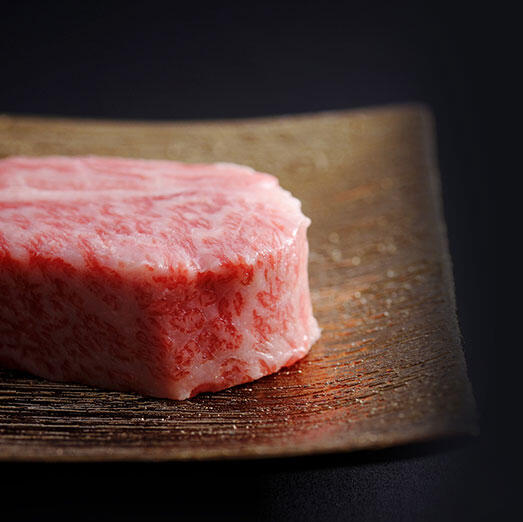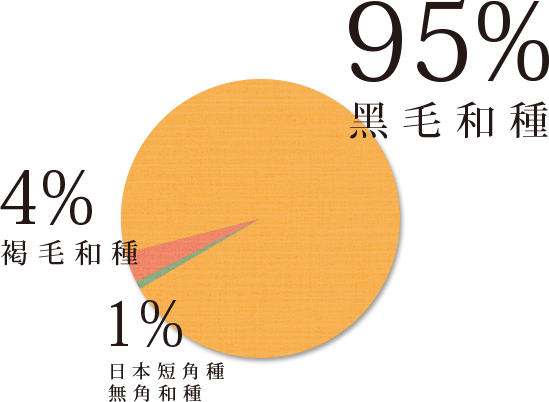

Place of production
【Annual Production of the Top Three Wagyu Beef Varieties】
- Matsusaka Beef (Matsusaka Ushi): 600 head of cattle
Tender meat with the most beautiful marbling - Kobe Beef (Kobe Beef): 7,000 head of cattle
The most stringent grading system - Ōmi Beef (Ōmi Gyu): 15,000 head of cattle
The first branded Wagyu.
【Three Major Wagyu Production Regions】
鹿兒島KAGOSHIMA: 18.3% Producing 100,000 head of cattle each year.
宮崎MIYAZAKI : 13.1% Producing 700,000 head of cattle each year.
北海道 HOKKAIDO : 10.3% Producing 600,000 head of cattle each year.

Kobe Beef
Kobe beef from Hyogo Prefecture, Japan, originates from purebred Tajima cattle. The term "Kobe beef" does not refer to live cattle anywhere in the world. Only after the purebred Tajima cattle are slaughtered, and if the meat meets the standards of the "Kobe Beef Marketing and Distribution Promotion Association," it is certified as "Kobe Beef." Unlike other Wagyu varieties named after locations, "Kobe" in Kobe Beef is a brand name, not a place name. Only the most strictly inspected purebred Tajima cattle qualify as "Kobe Beef." The classic impression Kobe beef leaves is its sweet and rich flavor.

Ōmi Beef
Ōmi beef, with a history of 400 years, is the oldest Wagyu brand in Japan, originating from the Edo period and was the only beef presented to the Shogunate government. In 1951, the Ōmi Beef Association was officially established, becoming the first registered Wagyu brand in Japan. Ōmi beef is raised in Shiga Prefecture, home to lush mountains and Japan's largest lake, Lake Biwa, known as the mystical lake. With abundant water resources, a rich natural environment, a mild climate, and its proximity to both mountains and water, this region has cultivated internationally renowned culinary delights.

Saga Beef
Saga beef is raised in Saga Prefecture on Kyushu Island. In the warm climate, stress-free farming methods result in tender meat with evenly distributed fat. Saga beef is renowned nationwide for its high quality and stable supply. The meat features soft, lean muscles interlaced with delicate and uniform fat, known as the famous "snow fat" beef. These delicious black-haired Wagyu cattle benefit from the mild climate, clean water, and fresh air of Saga.
To produce high-quality beef, special care is required from the time the cattle are calves, and skilled breeding techniques are crucial. To ensure the cattle do not experience any stress or burden, everything from feed mixing to other management practices is done in a gentle and comfortable manner. In Saga's beautiful natural environment, Saga cattle are raised with exceptional care from the farmers.

Kagoshima Beef
Kagoshima Prefecture, formerly known as Satsuma, is located in the southernmost part of the Kyushu region in Japan. It is famous for its warm climate and rich natural scenery, earning the nickname "the South of the country." Kagoshima is currently Japan's leading agricultural hub, surpassing even Hokkaido. It is renowned for Kagoshima black pork and Kagoshima Wagyu beef, and it is the largest producer of Wagyu beef in Japan.
Kagoshima black-haired Wagyu cattle are a local breed that has been raised for generations. Through successful breeding improvements and traditional farming methods in a comfortable environment, Kagoshima proudly produces high-quality and high-yield black-haired Wagyu beef. The fat distribution in the meat is considered perfect, with vibrant red meat and white, snow-like, fine, and even fat. The meat is glossy, tender, and smooth, with a rich flavor and a lingering delicious aftertaste.

Hida Beef
Gifu Prefecture, located in central Japan, is largely covered by dense forests and is famous for its clean water, fresh air, distinct four seasons, and significant temperature differences between day and night. In this lush natural environment, healthy cattle with fine marbling are peacefully raised. Hida beef specifically refers to black-haired Wagyu cattle that have been raised in Gifu Prefecture for at least 14 months.
According to the certification system of the Japan Meat Grading Association, only beef that meets grade A or B and has a meat quality score of 5, 4, or 3, and is certified by the Hida Beef Brand Promotion and Distribution Association, can be called Hida beef. The standout feature of Hida beef is its excellent marbling distribution, which creates patterns reminiscent of the scattered spots on a young deer, making it visually appealing as well.

Miyazaki Beef
Miyazaki beef, known as the champion cattle, ranks second in production in Japan. The evaluation standards require that the cattle be raised in Miyazaki Prefecture, with both parents being black-haired Wagyu from Miyazaki, meeting a grading standard of 4 or higher, and having excellent color. Only the best cattle are designated as "Miyazaki Beef."
Since becoming the champion at the "Wagyu Olympics" in 2007, the reputation of Miyazaki beef has gradually increased, and it also won the title of "Japan's Best Beef" in the 2017 competition, earning the market nickname "The New King." Additionally, Miyazaki beef is traditionally awarded to victorious sumo wrestlers in Japan's major sumo tournaments, becoming a longstanding custom.

Matsusaka Beef
Matsusaka Ushi is a prized cattle breed from Mie Prefecture, Japan, renowned for its superior meat quality and meticulous rearing methods. Matsusaka beef is produced in the beautiful city of Matsusaka, famous for its picturesque landscapes. The meat quality reaches perfection by raising only virgin female cattle, which are carefully tended to for three years.
The diet for Matsusaka cattle includes high-quality grains such as corn, barley, and soybean meal, with occasional supplements of beer mash to stimulate digestion. This special rearing method results in meat that is silky smooth with evenly distributed fat resembling clouds, creating a beautiful marbling pattern. Matsusaka beef is highly sought after in high-end Japanese cuisine, symbolizing culinary excellence and being a part of traditional Japanese food culture, reflecting meticulous attention to detail and quality.
Part

The front shank
Knuckle
Chuck tender
Brisket Point End (PE)
Chuck rib
Ribeye
Cap meat
Short loin
Special beef ribs
Beef ribs
Short ribs
Snowflake Beef
Inner skirt steak
Flat iron steak
Ba chỉ
Carp tube (Sinew meat)
Achilles tendon
Sirloin cap
Rump cap
Sirloin tip
tri-tip


Grading



Grade


Origin: Tottori, Tajima, Shimane, Okayama
The primary stage of this beef cattle breed in Japan accounts for approximately 95% or more of all Wagyu breeds. It is known for its color, marbling patterns, and quality density, producing stunning "snow fat" meat with large, beautiful marbling patterns.
Origin: Kochi, Kumamoto
Another major breed of Wagyu cattle, it has less fat compared to the black Wagyu breed, and its red meat is highly valued.
Origin of Shorthorn Breed: Aomori, Iwate
Origin of Polled Breed: Yamaguchi
The Japanese Shorthorn breed is well-suited to the northern Japanese climate, while the Polled Wagyu breed grows quickly but has less attractive marbling.
